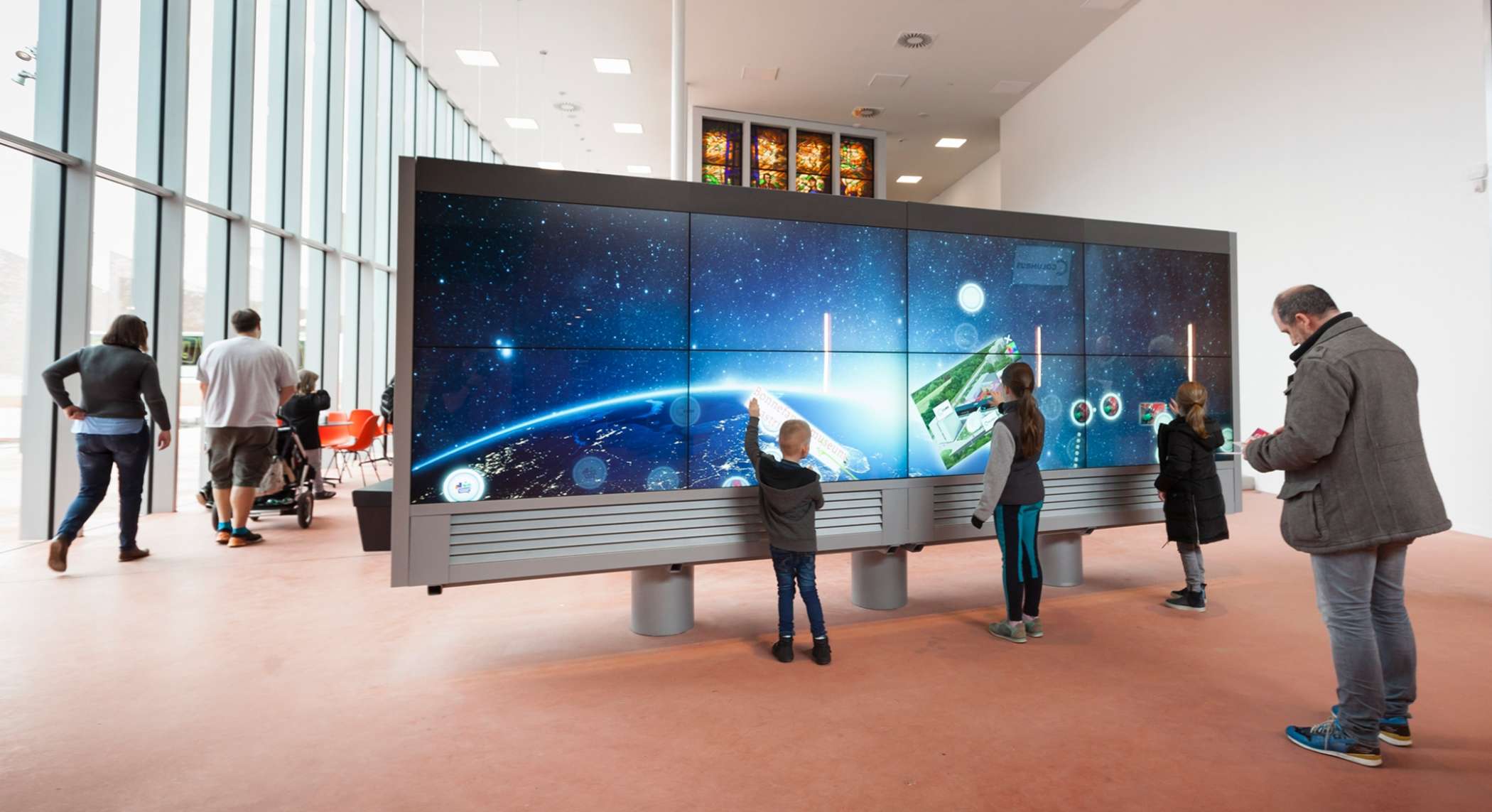
Rewriting the Map: An Immersive Journey at the National Museum of the American Indian
Forget static museum plaques and dusty dioramas. In an age where information demands dynamic engagement, the National Museum of the American Indian (NMAI) in Washington D.C. offers an experience that doesn’t just present history; it invites you to walk through it, to touch its contours, and to understand its profound, often painful, shifts. While NMAI itself is a monumental testament to Indigenous cultures, it’s the museum’s innovative approach to visualizing ancestral lands, particularly through its groundbreaking interactive Native American land maps, that truly redefines historical immersion.
Stepping into NMAI is an experience in itself. The building, designed by Douglas Cardinal (Blackfoot), feels organic, its curving lines and earthy tones a deliberate departure from the neoclassical architecture that dominates the D.C. landscape. It’s a structure that breathes, drawing inspiration from natural rock formations and Indigenous dwelling forms. This architectural philosophy—that the building itself is a part of the story—sets the stage for the deep, respectful engagement that awaits within. And at the heart of this engagement, anchoring many of its exhibits and discussions, is the powerful concept of land, sovereignty, and identity, brought to life with unprecedented clarity through interactive cartography.
The museum houses various installations that incorporate interactive mapping, but the most impactful are those that transcend simple geographical displays to become dynamic narratives. Imagine a sprawling digital canvas, perhaps a multi-touch tabletop or a wall-sized projection, that invites visitors to explore North America not as a blank slate awaiting discovery, but as a vibrant mosaic of nations, languages, and ecological stewardship that existed for millennia prior to European contact. This isn’t just a map; it’s a living archive, a time machine, and a profound challenge to conventional historical narratives.

With a simple gesture, a swipe, or a zoom, the user can peel back layers of time, revealing a continent far more complex and interconnected than standard colonial maps suggest. You can begin by visualizing the ancestral territories of countless Indigenous nations – the Anishinaabe stretching across the Great Lakes, the Navajo (Diné) commanding the vast landscapes of the Southwest, the Haudenosaunee Confederacy influencing regions now divided by state lines. The fluidity of these pre-colonial borders, often defined by natural features, seasonal movements, and complex diplomatic relationships rather than rigid lines, stands in stark contrast to the fixed rectangles imposed later.
The power of these interactive maps lies in their ability to layer information. Beyond mere boundaries, they overlay linguistic families, showing the incredible diversity of Indigenous languages and their geographical distribution. You can trace ancient trade routes, vibrant arteries of commerce and cultural exchange that crisscrossed the continent for millennia, long before European arrival. These routes weren’t just paths; they were cultural highways, facilitating the exchange of goods, ideas, ceremonies, and technologies, painting a picture of a continent bustling with sophisticated societies.
But the maps don’t stop at pre-contact prosperity. Their true genius, and their most poignant contribution, lies in their capacity to illustrate the devastating impact of colonization. With another touch, the map transforms, displaying the relentless encroachment of European settlements, the lines of treaties made and broken, and the inexorable march of forced removals. Watching the vibrant tapestry of Indigenous lands shrink, fragment, and transform under the pressure of colonial expansion is a visceral, emotional experience.
The maps meticulously detail the routes of forced displacement, such as the infamous Trail of Tears, showing the geographical expanse of the suffering endured by the Cherokee, Choctaw, Chickasaw, Creek, and Seminole nations. They highlight the lands ceded through coercive treaties, the establishment of reservations, and the systematic dismantling of Indigenous sovereignty. This visual chronology makes the abstract concepts of Manifest Destiny and the Indian Removal Act terrifyingly concrete. It’s one thing to read about land loss; it’s another to see the land literally disappear from the hands of its original stewards, replaced by colonial grids and state boundaries. This interactive experience isn’t just informative; it’s a profound act of witnessing.

Yet, the narrative doesn’t end with loss. The maps are also powerful tools for illustrating Indigenous resilience and revitalization. They show contemporary tribal lands, often mere fractions of ancestral territories, but still vital centers of cultural preservation, economic development, and political self-determination. They can highlight areas of language revitalization efforts, environmental conservation initiatives led by Indigenous communities, and ongoing land back movements. This layering of historical trauma with contemporary strength offers a more complete, nuanced, and ultimately hopeful understanding of Indigenous peoples’ ongoing relationship with their lands.
The technological sophistication of these installations at NMAI is impressive, utilizing high-resolution imagery, intuitive interfaces, and often incorporating augmented reality elements that allow visitors to "walk through" historical landscapes. The data underpinning these maps is meticulously researched, drawing from tribal archives, historical documents, oral histories, and contemporary geographic information systems (GIS). This commitment to accuracy ensures that the stories told are authentic and respectful, reflecting Indigenous perspectives rather than imposing external interpretations.
Beyond the specific map exhibits, the entire museum reinforces the importance of land. Whether it’s the Mitsitam Cafe, which serves Indigenous-inspired cuisine from five geographical regions, connecting food to the land it springs from, or exhibits showcasing agricultural practices, ecological knowledge, and sacred sites, NMAI consistently reminds visitors that for Indigenous peoples, land is not merely property but a fundamental aspect of identity, spirituality, and survival. The interactive maps serve as a foundational element, providing the geographical and historical context for everything else within the museum’s walls.
For any traveler with an interest in history, culture, or social justice, the interactive land maps at NMAI are an indispensable experience. They challenge the very notion of what a map is – transforming it from a static representation of territory into a dynamic, living narrative of human experience, resilience, and sovereignty. It’s a journey that shifts your perspective, humbles you with the weight of history, and inspires you with the enduring spirit of Indigenous nations.

Planning Your Visit:
The National Museum of the American Indian is located at 4th Street & Independence Ave SW, Washington, D.C., directly on the National Mall. As part of the Smithsonian Institution, admission is free, making it an accessible and essential stop for any D.C. itinerary. The museum is easily reachable via public transport (Smithsonian Metro Station). Allow at least 2-3 hours to fully explore, with extra time if you wish to delve deeply into the interactive maps and other digital exhibits. Weekday mornings are generally less crowded, offering a more serene environment for reflection. Don’t forget to visit the Mitsitam Cafe for a unique culinary experience that extends the museum’s narrative of Indigenous culture.
In a world increasingly reliant on digital tools, NMAI leverages technology not for novelty, but for profound historical revelation. The interactive Native American land maps are more than just exhibits; they are gateways to understanding, bridging vast historical divides and inviting every visitor to reconsider the very ground beneath their feet. This isn’t just a museum visit; it’s an educational pilgrimage, a necessary re-evaluation of history, and a powerful testament to the enduring presence and sovereignty of Indigenous peoples.

